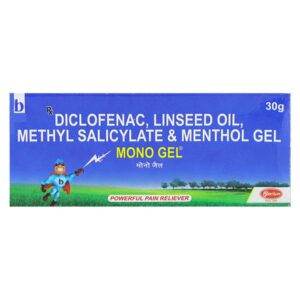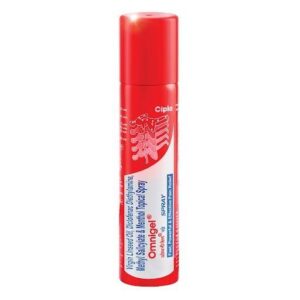MENTHOL + METHYL SALICYLATE + DICLOFENAC DIETHYL AMMONIUM + OLEUM
Menthol: Menthol is a natural compound derived from the peppermint plant. It is commonly used in various products such as cough drops, topical analgesics, and oral hygiene products due to its cooling and soothing effects.
The primary use of menthol is as a topical analgesic and decongestant. It provides a cooling sensation when applied to the skin, helping to relieve minor pain, itching, and irritation. Menthol is also used in certain cough drops and throat sprays to help soothe sore throats and reduce coughing. In addition, it is added to some oral hygiene products like mouthwashes and toothpaste for its refreshing and antiseptic properties.
The exact mechanism of action of menthol is not fully understood, but it is believed to stimulate the cold-sensitive receptors in the skin, resulting in a cooling sensation and temporary pain relief. It also has mild local anesthetic properties.
Menthol is available in various formulations, including creams, gels, ointments, sprays, and lozenges. The dose and application method depend on the specific product being used. It is important to carefully read and follow the instructions provided with each individual product.
Menthol is generally well-tolerated when used as directed. However, some individuals may experience mild side effects such as skin irritation, redness, or rash when applied topically. In rare cases, allergic reactions may occur, causing more severe symptoms such as difficulty breathing or swelling of the face, lips, or throat. If any unexpected or concerning side effects occur, it is essential to discontinue use and seek medical attention.
Methyl Salicylate: Methyl Salicylate is a topical analgesic drug that is often used to relieve pain associated with minor muscle aches, joint pain, and sprains. It is also commonly found in over-the-counter creams, gels, liniments, and ointments.
The mechanism of action of Methyl Salicylate involves its counterirritant effect. When applied on the skin, it produces a cooling sensation and promotes blood flow to the area. This sensory stimulation helps to distract from the underlying pain and provides temporary relief.
The usual recommended dose of Methyl Salicylate depends on the specific product being used. It is essential to carefully read and follow the instructions provided on the packaging label or as directed by a healthcare professional. Generally, a thin layer of the topical cream or ointment is applied to the affected area and gently massaged in until absorbed. It is important not to apply more than the recommended amount or use it more frequently than directed.
Like any medication, Methyl Salicylate can cause side effects, although they are typically rare and mild. Some common side effects that may occur include skin irritation, redness, itching, or a warming sensation at the application site. If these side effects worsen or persist, it is advisable to discontinue use and consult a healthcare professional.
It is important to note that Methyl Salicylate should not be used on broken skin, open wounds, or mucous membranes. Additionally, individuals who are allergic to salicylates or aspirin should avoid using products containing Methyl Salicylate. Pregnant or breastfeeding women should consult a healthcare professional before using this medication as well.
In summary, Methyl Salicylate is a topical analgesic commonly used for relieving minor muscle and joint pain. It works by producing a counterirritant effect and should be used according to the instructions provided. While side effects are usually minimal, any adverse reactions should be reported to a healthcare professional.
Diclofenac Diethyl Ammonium: Diclofenac Diethyl Ammonium is a non-steroidal anti-inflammatory drug (NSAID) that is commonly used to relieve pain and reduce inflammation in various conditions such as arthritis, osteoarthritis, and sports injuries.
The drug works by inhibiting the production of prostaglandins, which are chemical compounds responsible for pain and inflammation. It does this by blocking the action of an enzyme called cyclooxygenase (COX). By reducing the production of prostaglandins, diclofenac diethyl ammonium helps to alleviate pain and swelling in the affected areas.
Diclofenac diethyl ammonium is available in the form of a gel or cream, which is applied topically to the affected area. The recommended dose is typically a small amount of gel or cream, about the size of a one or two pence coin, depending on the size of the affected area. It is important to follow the instructions provided by the healthcare professional or the product label for the correct dose and duration of use.
As with any medication, diclofenac diethyl ammonium can cause some side effects. Common side effects include skin irritation, redness, itching, and rash at the site of application. These side effects are usually mild and temporary. However, if the irritation persists or gets worse, it is important to seek medical advice.
In rare cases, diclofenac diethyl ammonium can cause more serious side effects such as allergic reactions, including difficulty breathing, swelling of the face or throat, and hives. If any of these symptoms occur, immediate medical attention should be sought.
It is important to use diclofenac diethyl ammonium as directed and to avoid applying it to broken or damaged skin, as this may increase the risk of side effects or systemic absorption. It is also advisable to avoid applying the gel or cream near sensitive areas such as the eyes, mouth, or genitals.
As with any medication, it is important to consult a healthcare professional before using diclofenac diethyl ammonium, especially if you have any underlying health conditions, are pregnant or breastfeeding, or are taking other medications.
Oleum: Oleum is a medication that comes in the form of an oil and is used for various medical purposes. It has several applications including as a laxative, a moisturizer for dry skin, and as a lubricant for certain medical procedures.
The mechanism of action of Oleum as a laxative is through lubrication. It helps soften the stool and promotes its passage through the intestines, relieving constipation. As a moisturizer, Oleum helps replenish the skin’s natural oils, making it effective for the treatment of dry and irritated skin conditions. Additionally, it can be used as a lubricant during medical examinations, such as rectal or vaginal exams.
The appropriate dosage of Oleum depends on the specific condition being treated and should be determined by a healthcare professional. As a laxative, it is typically taken orally, with the recommended dose being 15-45 mL. For moisturizing purposes, it can be applied topically as needed. For lubrication during medical procedures, it is applied externally to the specific area.
Like any medication, Oleum can cause side effects. When used as a laxative, common side effects may include diarrhea, abdominal cramps, and nausea. If these side effects become severe or persist, it is important to consult a healthcare professional. When used as a moisturizer, Oleum is generally considered safe, but some individuals may experience skin irritation, redness, or allergic reactions. It is recommended to perform a patch test on a small area of skin before using it more extensively. As a lubricant during medical procedures, side effects are rare but may include discomfort or irritation.
It is important to note that Oleum should not be used orally or internally as a lubricant as there is a risk of aspiration or other complications. Additionally, it is not intended for use in newborns or infants.
As with any medication, it is crucial to follow the instructions provided by the healthcare professional and read the product label carefully before using Oleum. If any adverse reactions or concerns arise, it is always recommended to seek medical advice.


